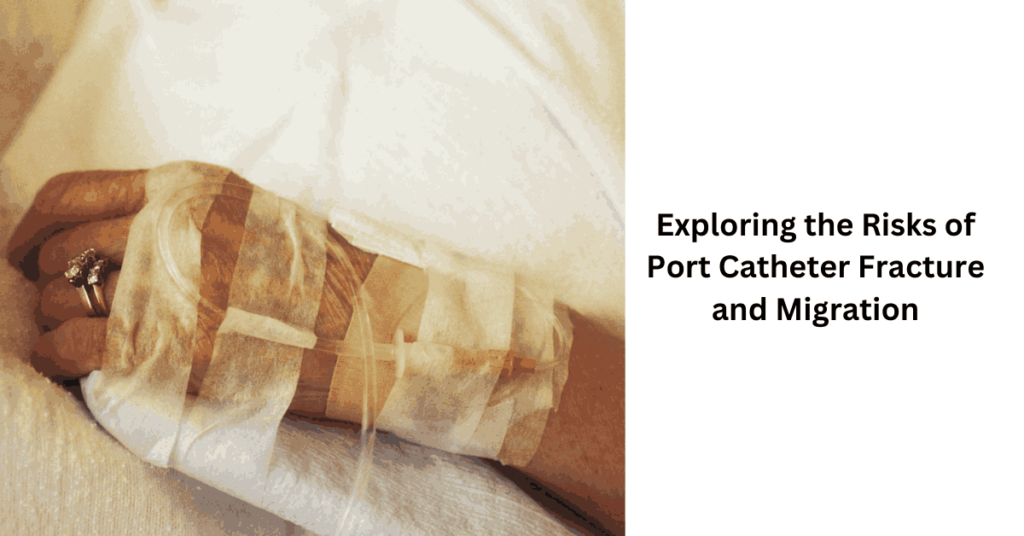Exploring the Risks of Port Catheter Fracture and Migration

Medical advancements have significantly improved the quality of life for patients requiring long-term intravenous treatments, with port catheters being a common solution. However, despite their benefits, port catheters pose certain risks, particularly concerning fracture and migration.
Understanding these potential complications is crucial for healthcare providers and patients alike, as it can aid in early detection and prevention.
Overview of Port Catheters
Port catheters, also known as implantable venous access devices, have become indispensable tools in modern healthcare. These small devices are surgically implanted beneath the skin to provide a stable and long-term access point to veins.
Typically made of materials like silicone or polyurethane, port catheters consist of a reservoir connected to a catheter. This allows healthcare professionals to administer medications, draw blood, or deliver fluids directly into the bloodstream. This minimizes the need for repeated needle insertions, making it a preferred choice for patients requiring frequent intravenous treatments.
Despite their benefits, port catheters come with inherent risks. According to Drugwatch, these include infections, thrombosis, and the focus of this article – fractures and migration. Understanding the complexities of these risks is essential for healthcare providers to make informed decisions and for patients to actively participate in their care.
Causes and Mechanisms of Catheter Fracture
Catheter fractures can arise from a myriad of factors, each presenting unique challenges. External mechanical stress is a primary contributor, occurring when the catheter experiences undue pressure or trauma. This can happen during activities such as aggressive physical exercise, accidental impacts, or even tight clothing constantly rubbing against the catheter site.
Furthermore, repetitive bending or kinking of the catheter may weaken its structure over time, making it more susceptible to fractures. Beyond patient-related factors, inherent design or manufacturing defects can play a role. Suboptimal materials or manufacturing processes may introduce weaknesses, compromising the catheter’s integrity.
Understanding these multifaceted causes allows healthcare providers to tailor preventive strategies based on individual patient profiles and address potential issues before they escalate.
Understanding the Phenomenon of Migration
The migration of port catheters is a complex phenomenon influenced by various factors. Anatomical considerations, such as changes in body composition or muscle contractions, can contribute to the gradual movement of the catheter.
Patient activities, particularly those involving repetitive motions or strain on the implantation site, can exacerbate the risk of migration. Additionally, issues related to the catheter itself, such as inadequate fixation or improper placement during the initial procedure, can contribute to unintended movement.
By comprehensively understanding these dynamics, healthcare providers can tailor their approach to minimize migration risks. This ensures the stability and efficacy of port catheters over the course of treatment.
Recognizing Signs and Symptoms
Early detection of catheter-related complications is pivotal for timely intervention and optimal patient outcomes. Recognizing the signs and symptoms of catheter fracture or migration empowers both healthcare providers and patients to act swiftly.
Pain or discomfort at the implantation site, difficulties in flushing the catheter, or unexplained changes in the effectiveness of treatments are key indicators. Additionally, visual cues such as swelling, redness, or palpable irregularities at the catheter site should not be overlooked.
Encouraging patients to communicate any unusual sensations promptly and maintaining open lines of communication are essential components of a proactive healthcare approach.
Complications and Health Consequences
Complications stemming from port catheter issues can have cascading effects on a patient’s health. In the case of catheter fracture, fragments may travel through the bloodstream, posing the risk of catheter embolism and potential organ damage.
As per information from MedlinePlus, kidney damage ranks among the prevalent complications associated with the use of urinary catheters.
Migration can compromise the catheter’s functionality, leading to suboptimal treatment outcomes or necessitating premature removal. Moreover, both scenarios elevate the risk of infections, adding an additional layer of complexity to patient care.
Addressing these complications promptly is imperative to mitigate potential health consequences, emphasizing the importance of vigilance and proactive management.
Legal Aspects and Lawsuits
According to TorHoerman Law, legal actions related to port catheter complications underscore the need for meticulous adherence to standards and transparent communication. Patients or their families may pursue lawsuits alleging negligence, product liability, or inadequate disclosure of risks.
The Bard PowerPort lawsuit is one example of a port catheter lawsuit. As per the Lawsuit Information Center, injuries such as infection, vascular damage, and deep vein thrombosis have been reported by the plaintiffs. As of January 2024, there are 99 lawsuits pending in the Bard PowerPort MDL.
Manufacturers and healthcare providers must prioritize patient safety, ensuring that products meet rigorous quality standards and that patients are thoroughly informed about potential complications. Maintaining accurate records, robust informed consent processes, and adherence to best practices in patient care can serve as protective measures against potential legal ramifications.
The inclusion of port-a-catheter migration symptoms in informed consent discussions and patient education is essential to empower individuals to recognize warning signs. This promotes early intervention and potentially averting more severe complications. By addressing legal aspects and emphasizing preventive measures, the healthcare community can work collaboratively to enhance patient safety.
Preventive Measures and Best Practices
Preventing port catheter complications requires a multifaceted approach that spans patient education, surgical techniques, and ongoing monitoring. Thorough patient education should cover proper care practices and alert patients to potential signs of complications.
Surgeons must adhere to best practices during the implantation procedure, emphasizing secure placement and minimizing trauma to the catheter.
Regular follow-ups, imaging studies, and collaborative efforts between patients and healthcare professionals should be prioritized to enable early detection and intervention. This comprehensive strategy enhances the safety and effectiveness of port catheters, ultimately improving patient outcomes.
In conclusion, the intricate landscape of port catheter risks necessitates a vigilant and collaborative approach from healthcare providers, patients, and manufacturers. Recognizing the multifactorial causes of fractures and migration, early detection of symptoms, and addressing complications promptly are crucial.
Legal aspects highlight the importance of transparent communication and adherence to standards. Proactive patient education, meticulous surgical techniques, and ongoing monitoring are integral components of a multifaceted preventive strategy.
By prioritizing patient safety and fostering a shared commitment to best practices, the healthcare community can navigate the challenges posed by port catheter complications. This ensures the sustained efficacy of these devices and improves overall patient outcomes.


